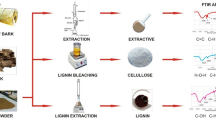Abstract
LC–MS analyses of saponin fractions of Achyranthes roots in the Japanese market revealed that there were three patterns for the saponin fraction of their water extracts, i.e., the saponins with a sugar moiety at position 28 [achyranthosides B (3), C (4) and D (5)] were the major constituents, the saponins without sugar moiety at position 28 [betavulgarosides II (10) and IV (11)] were the major constituents, and mixtures of these saponins. In a decoction prepared from the sample which contained 10 and 11 as the major saponins, their amounts were largely decreased compared with those of the water extract. As large amounts of these saponins were found in the precipitates formed by heating of the water extract, these saponins were seemed to precipitate out under heating. When hot water was used for the extraction, 3, 4 and 5 were detected even from the samples whose water extract did not contain these saponins. This was attributed to inhibition of endogenous esterase which hydrolyzes the ester linkage at position 28. When saponins were extracted with reagent grade 1-butanol, in addition to the decrease of the amounts of highly polar saponins, oxidative decarboxylation of 3 and 10 occurred resulting in formation of achyranthoside E (6) and spinacoside D (12), respectively. As these changes were not observed with HPLC grade 1-butanol, which contain not more than 5 ppm of peroxide impurities, the change was attributable to the peroxide impurities contained in the reagent grade 1-butanol.









Similar content being viewed by others
References
Ministry of Health, Labor and Welfare (2016) The Japanese pharmacopoeia seventeenth edition (Ministry Notification No. 64 of Mar 7, 2016) p 1793
Ida Y, Katsumata M, Satoh Y, Shoji J (1994) Glucronide saponins of oleanolic acid from Achyranthes fauriei roots. Planta Med 60:286–287
Ida Y, Satoh Y, Katoh M, Katsumata M, Nagasao M, Yamaguchi K, Kamei H, Shoji J (1994) Achyranthosides A and B, novel cytotoxic saponins from Achyranthes fauriei root. Tetrahedron Lett 35:6887–6890
Ida Y, Satoh Y, Katsumata M, Nagasao M, Shoji J (1995) Achyranthosides C and D, novel glucuronide saponins from Achyranthes fauriei root. Chem Pharm Bull 43:896–898
Ida Y, Satoh Y, Katsumata M, Nagasao M, Hirai Y, Kajimoto T, Katada N, Yasuda M, Yamamoto T (1998) Tow new oleanolic acid saponins having a sialyl Lewis X mimetic structure from Achyranthes fauriei. Bioorg Med Chem Lett 8:2555–2558
Ando H, Fukumura M, Hori Y, Hirai Y, Toriizuka K, Kuchino Y, Ida Y (2008) Two new glucuronide saponins, Achyranthosides G and H, from Achyranthes fauriei root. J Nat Med 62:57–62
Yoshikawa M, Murakami T, Kadoya M, Matsuda H, Yamahara J, Muraoka O, Murakami N (1995) Betavulgarosides I, II, III, IV, and V, hypoglycemic glucuronide saponins from the roots and leaves of Beta vulgaris L. (sugar beet). Heterocycles 41:1621–1626
Yoshikawa M, Murakami T, Kadoya M, Matsuda H, Muraoka O, Yamahara J, Murakami N (1996) Medicinal foodstuffs. III. Sugar beet (1): hypoglycemic oleanolic acid oligoglycosides, betavulgarosides I, II, III, and IV, from the root of Beta vulgaris L. (Chenopodiaceae). Chem Pharm Bull 44:1212–1217
Yoshikawa M, Murakami T, Kadoya M, Yamahara J, Matsuda H (1998) Medicinal foodstuffs. XV. Sugar beet (2): structures of betavulgarosides V, VI, VII, VIII, IX, and X from the roots and leaves of sugar beet (Beta vulgaris L., Chenopodiaceae). Chem Pharm Bull 46:1758–1763
Yoshikawa M, Murakami T, Hirano K, Matsuda H, Yamahara J, Ohtani K, Kasai R, Yamasaki K (1998) Absolute stereochemistry of spinacosides C and D with a novel acetal type substituents from Spinacia oleracea (spinach) and Basella rubra (Indian spinach). Heterocycles 49:93–96
Wang GS, Cong DL, Yang JZ, Yang XH (2005) The triterpenoid saponins in Achyranthes bidentata Bl. Chin J Med Chem 15:224–226
Wang GS, Zhou XP, Yang XH, Xu JD (2004) Study on the acidic triterpenoid saponins of Achyranthes bidentata Bl. Chin J Med Chem 14:40–42
Hoshino T, Narukawa Y, Haishima Y, Goda Y, Kiuchi F (2012) Two new sulfated saponins from Achyranthes root. J Nat Med 67:386–389
Kawahara Y, Hoshino T, Morimoto H, Shimizu T, Narukawa Y, Fuchino H, Kawahara N, Kiuchi F (2016) LC-MS based quantification method for Achyranthes root saponins. J Nat Med 70:102–106
Iwamoto M, Okabe H, Yamauchi T (1985) Studies on the constituents of Momordica cochinchinensis Spreng. II. Isolation and characterization of the root Saponins, momordins I, II and III. Chem Pharm Bull 33:1–7
He G, Guo W, Lou Z, Zhang H (2014) Achyranthes bidentata saponins promote osteogenic differentiation of bone marrow stromal cells through the ERK MAPK signaling pathway. Cell Biochem Biophys 70:467–473
Xu X-X, Zhang X-H, Diao Y, Huang Y-X (2017) Achyranthes bidentata saponins protect rat articular chondrocytes against interleukin-1b-induced inflammation and apoptosis in vitro. Kaohsiung J Med Sci 33:62–68
http://mpdb.nibiohn.go.jp/mpdb-bin/list_data.cgi?category=sample&crude_drug_id=21&lang=en
Acknowledgements
The authors are grateful to Dr. Yutaka Yamamoto of Tochimoto Tenkaido Ltd. for providing crude drug samples. Thanks are also due to Mr. Takeshi Kawasaki of Uchida Wakanyaku Ltd. for providing information on Achyranthes root. This work was supported in part by MEXT-Supported Program for the Strategic Research Foundation at Private Universities from the Ministry of Education, Culture, Sports, Science and Technology, Japan.
Author information
Authors and Affiliations
Corresponding author
Ethics declarations
Conflict of interest
The authors declare that they have no conflict of interest.
Additional information
Publisher's Note
Springer Nature remains neutral with regard to jurisdictional claims in published maps and institutional affiliations.
Rights and permissions
About this article
Cite this article
Kuwada, K., Kawase, S., Nakata, K. et al. LC–MS analysis of saponins of Achyranthes root in the Japanese market. J Nat Med 74, 135–141 (2020). https://doi.org/10.1007/s11418-019-01355-y
Received:
Accepted:
Published:
Issue Date:
DOI: https://doi.org/10.1007/s11418-019-01355-y




